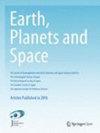On a large magmatic fluid reservoir oblique to the volcanic front in the southern part of NE Japan revealed by the magnetotelluric survey
IF 2.5
3区 地球科学
引用次数: 0
Abstract
Abstract Many active volcanoes and various types of seismic activities exist in the southern part of the Northeast Japan subduction zone. One of the geologically most interesting features in this area is the sequential explosive eruptions of a group of volcanoes. The group consists of Mt. Azuma and Mt. Adatara on the volcanic front line, Mt. Bandai west of the volcanic front, and Mt. Numazawa on the back-arc side. A previous petrological study on the eruption products regarded Mt. Numazawa as an anomalous back-arc volcano because its lavas are similar to those of volcanoes on the volcanic front. The reason behind this unique connection was unclear, and hence, this study was intended to understand the deep fluids distribution beneath the area. For this purpose, a 3-D regional electrical resistivity structure was estimated from a series of wide-band magnetotelluric surveys, with 45 observation points deployed from the fore-arc to the back-arc sides. The most important feature of the resistivity structure is a large conductive zone in the central part of the area, spanning from the upper mantle to the lower crust. Interestingly, the lateral elongation of the conductor is oblique to the volcanic front line and consistent with the spatial distribution of the group of volcanoes and the low-frequency earthquake clusters around them. Therefore, the conductor most likely represents a large, elongated magmatic fluid reservoir beneath the volcanoes. Hydrous partial melting might be the cause of the enhanced conductivity. Graphical Abstract大地电磁测量揭示的日本东北部南部斜向火山锋的大型岩浆流体储层
摘要日本东北部俯冲带南部存在多座活火山和多种类型的地震活动。这个地区最有趣的地质特征之一是一群火山的连续爆发。该群由火山前线的阿祖马山和阿达塔拉山,火山前线以西的万代山和弧后侧的沼泽山组成。以往关于喷发产物的岩石学研究认为,沼泽火山的熔岩与火山锋上的火山熔岩相似,属于弧后异常火山。这种独特联系背后的原因尚不清楚,因此,这项研究旨在了解该地区深层流体的分布。为此,通过一系列宽带大地电磁测量,从弧前到弧后两侧共部署了45个观测点,估算了三维区域电阻率结构。该区电阻率结构最重要的特征是该区中部有一个从上地幔延伸到下地壳的大型导电带。有趣的是,导体的横向伸长向火山前线倾斜,与火山群及其周围低频地震群的空间分布一致。因此,导体极有可能代表火山下面一个巨大的、细长的岩浆流体储层。含水部分熔融可能是电导率增强的原因。图形抽象
本文章由计算机程序翻译,如有差异,请以英文原文为准。
求助全文
约1分钟内获得全文
求助全文
来源期刊

Earth, Planets and Space
地学天文-地球科学综合
CiteScore
5.80
自引率
16.70%
发文量
167
期刊介绍:
Earth, Planets and Space (EPS) covers scientific articles in Earth and Planetary Sciences, particularly geomagnetism, aeronomy, space science, seismology, volcanology, geodesy, and planetary science. EPS also welcomes articles in new and interdisciplinary subjects, including instrumentations. Only new and original contents will be accepted for publication.
 求助内容:
求助内容: 应助结果提醒方式:
应助结果提醒方式:


